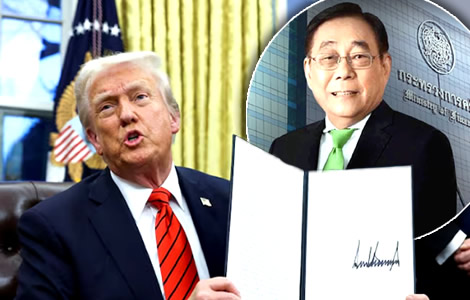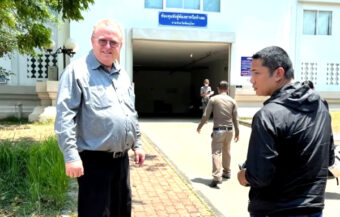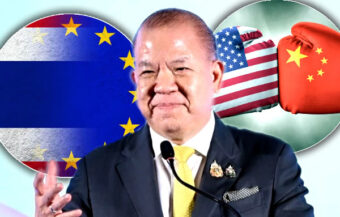Thailand braces for Trump’s sweeping new tariffs as the US abandons decades of free trade. The move under a rarely used 1930 law threatens exports, economic growth and key industries. Officials scramble to assess the impact while businesses fear rising costs and job losses.
Thailand is bracing itself for the first onslaught of Trump tariffs that are expected to impede exports and economic growth this year. On Thursday, the White House confirmed that the order would be signed imminently. Earlier in the week, Minister of Finance Pichai Chunhavajira suggested that Thailand must accept higher US imports going forward. The move to introduce reciprocal tariffs under Section 238 of the 1930 US Trade Act is the first time that the provision has been used. Indeed, the last time it was invoked was just before World War II against Axis powers. In short, the world is about to experience a massive shift as the United States abandons free trade principles introduced in the aftermath of the last world war.

Thailand’s economic cabinet was waiting on confirmation from Washington, DC, on Thursday as President Trump’s team indicated that he would sign an order regarding reciprocal tariffs.
In particular, these are automatic tariffs under Section 238 of the 1930 Trade Act.
Certainly, it is a legal mechanism that has not been used before. This comes despite the law being on the books for ninety-five years. The law was passed during the presidency of Herbert Hoover. However, despite being threatened against Axis powers in later years, it was never used by US President Franklin Delano Roosevelt.
Trump revisits rarely used Section 238 tariff law to target trade partners like Thailand and India
Previously, in the first term of President Trump, it was reviewed by advisers. In short, they were attracted to its sweeping power. Basically, the President can impose the regime given a 30-day notice period.
On Wednesday and Thursday, it emerged that both India and Thailand are particularly vulnerable to the regime.
For instance, Thailand uses tariffs as a trade protection for many of its industries. In turn, the tariffs applied by the kingdom against the United States will now be applied to Thailand by Washington, DC.
On Monday, Thailand’s Deputy Prime Minister and Minister of Finance, Pichai Chunhavajira, gave some hints at Thailand’s response.
In brief, he told reporters that the kingdom must prepare to import more American-made goods. Certainly, this would mean Thailand reducing its tariffs in response to America’s new regime.
Thailand’s trade surplus with the US under threat as Trump signals reciprocal tariffs on key exports
The kingdom recorded a trade surplus of $35.4 billion with the United States in 2024. This notably compares to a trade deficit with China in the opening six months of 2024. At length, this figure was $19.967 billion, up 15.66% from the year before.
Therefore, it is clear that the relationship between the United States and Thailand is exactly the opposite of what it is with China. At the same time, the United States is recently Thailand’s biggest export market, accounting for 18.3% of outward shipments last year. That is a whopping ฿54.96 billion.
For instance, Thailand is subjected to an 11.5% tariff rate on exports to the United States. Notably, the rate applied to Vietnam is only 5.1%, with 12% for India.
For example, Thailand currently imposes a massive 200% tariff on imported cars into the kingdom. The new reciprocal tariff regime will see the United States charge a similar tariff in the other direction.
Thai officials scramble to analyze US tariff moves as the economy faces further external headwinds
Certainly, in the next 24 hours, Thai officials will be studying the news from the White House. Indeed, they will be paying close attention to the fine print and details of any orders.
It comes as Thailand recorded a significant 5.1% rise in exports in 2024. Despite this and a 26% rise in foreign tourist arrivals, it is still projected to only grow by 2.5% for last year. The economy was retarded by lower private investment and consumption. In short, the kingdom’s economy is not well-placed to cope with any further adversity.
It comes as Trump, only inaugurated on January 20th, has shaken up the world in terms of trade and politics. Already, the suspension of US aid payments has impacted healthcare on the Thai-Myanmar border. Similarly, these suspended funds have hit many non-governmental organizations (NGOs) working in Thailand.
In the meantime, the administration had signalled a commitment to finalising its tariff review by April 1st or the end of March 2025. At length, the United States has already implemented a further 10% tariff on Chinese imports on February 4th last. In turn, China responded with retaliatory tariffs of its own, which went into effect on Monday, February 10th.
Trump’s trade war policies revive pre-WWII tariff strategies, impacting Thailand and global markets
Undeniably, Trump’s moves are seismic in nature. They basically jettison the World Trade Organization (WTO) and even US trade policy starting in 1947 with the General Agreement on Tariffs and Trade.
For instance, it has long been accepted that the first Trump trade war, which came about in 2017, severely impacted Thailand. This new regime could possibly be even more damaging. It is nothing less than historical.
When the Communist Party took over in China in 1949, the United States cut off all links with the mainland. Indeed, that year, Secretary of State Dean Acheson referred to Section 238 of the 1930 Trade Act. However, it was suspended by events—basically, all commerce stopped, particularly in the 1950s during the Korean War.
Limited trade between China and the United States emerged again in the 1970s. Later, in 1979, the two countries established full diplomatic relations. After that, trade rose from $4 billion to $750 billion in 2022. Nonetheless, it is now in decline. So is the global world supply network and the basis on which Thailand’s economy previously flourished.
Thai baht under pressure as investors brace for potential economic slowdown linked to US tariffs
Certainly, in Bangkok financial circles this week, there has been concern. Buoyed by a 16-22% boost in tourist arrivals at the strat of 2025, the Thai baht had been gaining. Indeed, it gained no less than 2.7% in the last month, valued at ฿33.817 against the dollar.
On Thursday, forecasters suggested that the baht would fall in the aftermath of Trump’s new tariff measures. After that, we are still waiting not only for the details but perhaps for negotiations that may ensue in the 30-day window.
However, some forecasters are suggesting a rate of ฿36 to the dollar in the second quarter of 2025. This would be driven by reduced tourist arrivals and the new Trump tariffs.
Certainly, this is all not coming at a good time. Thailand is witnessing the erosion of its manufacturing base.
In brief, this is due to the country’s lagging economy, massive business debts and chronic problems within the economy. At length, Thailand’s factories can no longer compete against more intense competition.
Thai manufacturing declines as regional trade trends and US-China tensions reshape supply chains
For instance, the Regional Comprehensive Economic Partnership (RCEP) has opened up Thai firms to competition from other ASEAN nations and China.
At the same time, huge Chinese conglomerates are dumping unsold products on the Thai market. Therefore, Thai firms are closing their doors. Research just released by Kasikorn Research Centre shows that the trend is slowing, although manufacturing output continues to decline.
At length, it was off by 2% year-on-year in the last quarter of 2024. The industries most damaged are furniture, clothes, automobiles, and steel. Consequently, from 2021 to 2022, 4,855 factories closed. Simultaneously, there were 1,818 new factories opened.
In short, the kingdom lost 127 factories per month. From 2023 to 2024, the trend decreased. In effect, 4,302 factories closed in this period while 3,034 opened. Therefore, Thailand saw 53 factory closures per month in this two-year period.
Factory closures and job losses rise in Thailand as economic pressures mount from global trade shifts
Finally, this has seen substantial job losses. Thirty-six people were hired for each new factory, while substantially more—52—lost their jobs when old plants closed. In addition, more workers were placed on shorter hours with no overtime.
For example, in the first six months of 2024, 457,000 workers were on part-time hours. Significantly, this was an 11% increase from 2023, when the same figure was 412,000 workers.
Trump Presidency already having a heavy impact on Thailand even before he talks trade with Bangkok
Hopes dashed as the Thai economy sputtered in the 4th quarter of 2024. Only 2.5% growth now expected
“This impacts low-income employees in the manufacturing sector, weakening their purchasing power. We anticipate more factories will close this year than last,” noted the Kasikorn Research Centre.
Undoubtedly, Thailand is presently facing a watershed moment as the world drifts back to a US trade regime last seen in the days leading up to World War Two.
Join the Thai News forum, follow Thai Examiner on Facebook here
Receive all our stories as they come out on Telegram here
Follow Thai Examiner here
Further reading:
Trump Presidency already having a heavy impact on Thailand even before he talks trade with Bangkok
Trump Presidency already having a heavy impact on Thailand even before he talks trade with Bangkok
Economy sees sharp setback with lower private spending, investment and foreign tourism income
Trump’s trifecta triumph means Thailand will be more on edge as he prepares to take power in January
Ung Ing congratulates Trump as Thailand uneasily confronts the meaning of his second Presidency


















